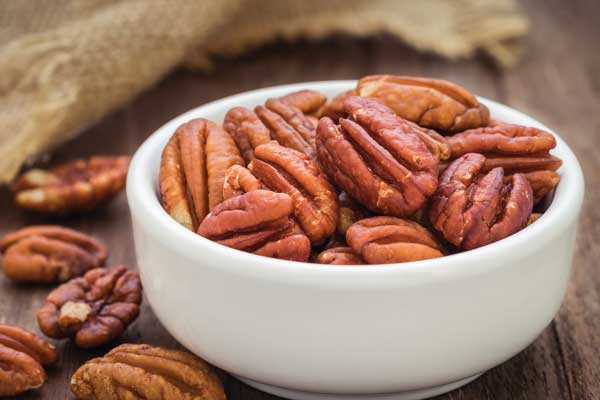Adventurous Eating Tops Trends; Hot Brewing Boosts Coffee Antioxidants
NEWS

Characterization of volatile compounds in pecans
Volatile compounds are responsible for the characteristic aroma of raw and roasted pecans. Yet much is unknown about the specific effects of roasting on pecan volatiles. In a recent study published in the Journal of Food Science, the volatiles of raw “ Desirable” pecans from Georgia and three roasted pecan samples (175°C for five, 10, and 15 minutes) were determined by HS-SPME coupled to GC-MS using stable deuterium-labeled volatiles as internal standards for quantitation.
As expected, roasting markedly affected the volatile profile of pecans: a total of 63 flavor-active compounds were identified in roasted samples, including nine compounds not detected in raw “Desirable” pecans. Pyrazines, notable indicators of the Maillard reaction, were found only in roasted samples and demonstrated continual increases throughout observed roasting times. Furthermore, hydrocarbon derivatives showed substantial increases with roasting, likely a result of the degradation of nonvolatile lipids.
The observed changes correspond well to prior sensory investigations concerning the impact of roasting on pecan flavor, and explain increases in intensity for roasted, nutty, buttery, and sweet sensory traits. The study’s documentation of the volatile constituents generated during the roasting of pecans may help formulators to develop natural and artificial pecan flavors in new food products.
Adventurous eating tops 2019 trends
Targeting increasingly adventurous consumers set on new discoveries and experiences will be key to developments in the food and beverage industry in 2019, according to Innova Market Insights’ Top Ten Trends. The connected world has led consumers of all ages to become more knowledgeable of other cultures, contributing to 35% growth of “discovery” claims, when comparing 2017 and 2016 new product launch numbers.
According to Innova, consumers are moving out of their comfort zones to explore bolder flavors and multisensory food experiences, resulting in a focus on heightened sensory delivery, often combined with an element of the unexpected.
Other trends topping Innova’s list include a continued emphasis on plant-based foods. Companies and brands are greening up their portfolios to attract mainstream consumers who want to add more plant-based options into their diets in a quest to achieve a healthy and sustainable balance between meat and vegetables, rather than adopting an all-or-nothing way of eating.
Replacement foods and ingredients are another top trend, with one in two U.S. consumers reporting that health is a reason for buying alternatives to bread, meat, or dairy. The search for alternative proteins has resulted in a rising use of black beans, lentils, peas, rice, nuts and seeds, chickpeas, and even insects as protein ingredients for foods.
Green appeal, Innova’s No. 4 trend, is increasingly driving corporate goals, as manufacturers commit to sustainable product and packaging development with a range of initiatives. This includes waste reduction through upcycled ingredients and post-consumer recycling, as well as improved biodegradability and new technology, such as compostable capsules and vegetable inks.
Rounding out the top five list is snacking. Innova’s research shows that the way people think about snacking and what is considered a snack is changing. Snacking is no longer the optional extra but the “definitive occasion” and a central focus of innovation across all food and beverage categories as reflected in a 10% average annual growth of global food and beverage launches with a snacking claim over the past five years (CAGR 2013–2017).
 Hot brewing boosts antioxidants in coffee
Hot brewing boosts antioxidants in coffee
Chemical differences between hot- and cold-brewed coffee may have health impacts, according to a new study by researchers at Jefferson (Philadelphia University + Thomas Jefferson University). In particular, hot-brewed coffee was shown to have higher levels of antioxidants, which are believed to be responsible for some of the health benefits of coffee.
The study, published in Scientific Reports, also found that the pH levels of both hot and cold coffee were similar, ranging from 4.85 to 5.13 for all coffee samples tested. Coffee companies and lifestyle blogs have tended to tout cold brew coffee as being less acidic than hot coffee and thus less likely to cause heartburn or gastrointestinal problems.
While the popularity of cold brew coffee has soared in recent years, with the U.S. market experiencing 580% growth from 2011 to 2016, the researchers found almost no studies on cold brew. At the same time, there is well-documented research that hot-brewed coffee has some measurable health benefits, including lower risk of some cancers, diabetes, and depression.
Researchers Niny Rao and Megan Fuller, both coffee drinkers, embarked on the study to discover whether the chemical make-up of cold brew differed from that of hot coffee. While the overall pH levels were similar, Fuller and Rao found that the hot-brewed method yielded more total titratable acids, which may be responsible for the hot cup’s higher antioxidant levels. “Coffee has a lot of antioxidants; if you drink it in moderation, research shows it can be pretty good for you,” Fuller said.
Considering that hot and cold brews have comparable pH levels, coffee drinkers should not consider cold brew a “silver bullet” for avoiding gastrointestinal distress, added Rao.
Convenience and cost drive canned goods growth
U.S. demand for canned foods is forecast to grow 1.9% annually in nominal terms through 2022, according to a report recently released by Freedonia Focus Reports. Ongoing growth in personal disposable incomes and spending at foodservice establishments will boost sales of canned food to the consumer and foodservice market, respectively, as the convenience and affordability of canned food continues to represent a key buying factor.
Increasing levels of disposable personal income are also a factor, supporting consumer spending on premium canned goods that offer high-quality food in a convenient format. However, the perception among many consumers that fresh food is healthier than canned food, as well as ongoing interest in cooking and consuming fresher meals, will continue to restrain faster demand growth.
What influences consumer food choices?
Consumers are increasingly making food and beverage choices based on their personal definition of health, choosing food described as natural, organic, high in protein, or functional, according to research from Technomic. Of the 1,500 consumers who took part in the research, 40% say their definition of health has changed over the past two years.
When dining out, 66% of consumers look for calorie counts on restaurant menus at least some of the time. Thirty-four percent say they’d be likely to order dishes made with vegetables, such as cauliflower pizza crust and zucchini noodles, instead of carb-rich items. However, they may reconsider their orders if they think an item has too many calories, a view that has implications for restaurants, which are now required to post calorie counts.
“The foodservice landscape will become more competitive when it comes to tastier, more innovative healthy menu offerings,” says Maia Chang, senior research analyst at Technomic. “This means that more brands will face additional pressure to differentiate through transparency and preparation techniques, as well as brand and sourcing stories.”
News Bites
• Blommer Chocolate announced that it has entered into an agreement to be acquired by Fuji Oil Holding, a global leader in oil and fat ingredients serving the food industry.
• Cargill and Royal DSM, a global science-based company in nutrition, health, and sustainable living, announced a new joint venture, Avansya, which will produce steviol glycoside products made through fermentation and marketed under the brand name EverSweet.
• Delicato Family Vineyards received the International Wine & Spirit Competition’s USA Wine Producer of the Year award. Based on the winery’s sustained excellence, it received the esteemed award for the fifth time since 2001.
• Diageo has agreed to the sale of 19 brands in an agreement with Sazerac for an aggregate consideration of $550 million.
• Diana Food has completed the successful launch of the company’s newest facility, an ultramodern chicken processing plant in Banks County, Ga.
• The U.S. Food and Drug Administration recently announced a qualified health claim for oils high in oleic acid, including U.S.-grown high oleic soybean oil, and their relationship to a reduced risk of coronary heart disease when replacing oils higher in saturated fats.
• Golden State Foods, one of the longest-serving suppliers to McDonald’s, completed the sale of nine of its 27 distribution centers to Martin Brower.
• Impossible Foods announced plans to sell its plant-based burgers at grocery stores in 2019.
• Keurig Dr Pepper and Danone Waters of America jointly announced that KDP will sell, distribute, and merchandise evian across the United States as part of a long-term master distribution agreement designed to accelerate the brand’s growth.
• Lancaster Colony announced that its wholly-owned subsidiary, T. Marzetti, has acquired all the assets of Omni Baking for a purchase price of $25 million.
• Perfect Day, a global leader in the research, development, and production of animal-free dairy, has announced a joint development agreement with Archer Daniels Midland to develop and commercialize animal-free dairy proteins in 2019.
• Puratos’ state-of-the-art manufacturing facility, located in Pennsauken, N.J., won a New Jersey Manufacturing Award for Advanced Manufacturing (South Region).
• Sovos Brands has completed a transaction to merge noosa yogurt into the Sovos portfolio of brands.
• TorQuest Partners announced the acquisition of Bartek Ingredients, a specialty products manufacturer specializing in malic acid, fumaric acid, and maleic anhydride for food and beverage, animal nutrition, and industrial applications.
• Vintage Wine Estates has purchased the wine brand Qupé.
 Margaret Malochleb,
Margaret Malochleb,
Associate Editor
[email protected]
